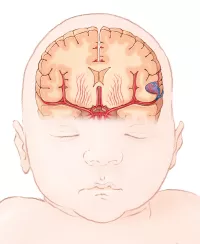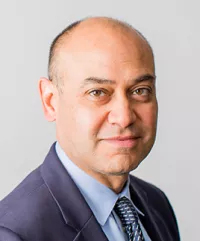
Arteriovenous malformations (AVMs) are an abnormal tangle of arteries and veins that disrupt the blood flow and oxygen circulation in the brain. While AVMs can rupture and result in bleeding in the brain, unruptured AVMs may also cause symptoms like headaches, seizures, and/or neurological deficits. However, for some patients, their unruptured AVMs may not present with symptoms and are discovered by chance, otherwise referred to as incidentally, during unrelated medical care.
Although AVMs in children are extremely rare, representing only 3% of the 3,000 cases diagnosed every year, they tend to rupture more frequently than in adults and can result in serious complications.
To better understand and guide future decision-making for the treatment of unruptured, incidental AVMs in children, UCSF neurosurgery resident Alex Lu, MD, and Chief of Pediatric Neurosurgery Nalin Gupta, MD, PhD, analyzed a database spanning 24 years of pediatric AVM patients who were treated at UCSF. Their study, published recently in the Journal of Neurosurgery Pediatrics, compared the size, vein architecture, and management of incidental vs symptomatic AVMs.

Nalin Gupta, MD, PhD
“AVM hemorrhage can result in severe disabilities. Studies like this one allow us to understand how AVMs behave before they have had a chance to hemorrhage, and hopefully lead to early treatment,” said Gupta.
The researchers found that, compared to 66 symptomatic AVM cases, the 10 cases of incidental AVMs in the study comprised of smaller AVMs with veins that were closer to the surface and surgically accessible. The incidental AVMs that were smaller than 3cm were removed surgically.
On the other hand, patients who experienced symptomatic AVMs were found to have larger lesions that were sometimes deeply situated in the brain, which are challenging to surgically access. In AVMs where surgery was not feasible, treatments also included embolization and gamma knife radiation, both minimally invasive options.
As one of the firsts, the study also suggests that pediatric AVMs may grow over time without treatment, as found in a patient with an incidental AVM who presented with recurring headache symptoms and whose AVM demonstrated growth.

“UCSF is a high-volume center and we have the expertise to treat these AVMs very safely. If the AVM is unruptured, the outcomes are excellent. If an AVM was found incidentally in a child, whether it was due to a head injury or through another study, this can help guide the decision-making regarding treatment,” said Lu.
Paper(s) cited:
Lu A Y, et al.
A comparison of incidental and symptomatic unruptured brain arteriovenous malformations in children
J Neurosurg Pediatr. 2023 Feb 17;1-6. doi: 10.3171/2023.1.PEDS22541. Online ahead of print.
